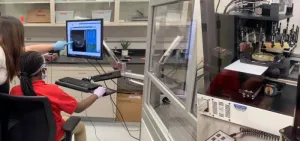(Press-News.org) McGill University scientists have discovered that pregnancy may trigger a natural immunity to boost protection against severe flu infection.
Contrary to the common belief that pregnancy increases vulnerability to infections, researchers found that it strengthened an immune defense in mice, blocking the Influenza A virus from spreading to the lungs, where it can cause severe infection.
“Our results are surprising because of the current dogma, but it makes sense from an evolutionary perspective,” said co-lead author Dr. Maziar Divangahi, Professor in McGill’s Faculty of Medicine and Health Sciences and Senior Scientist at the Research Institute of the McGill University Health Centre (The Institute).
“A mother needs to stay healthy to protect her developing baby, so the immune system adapts to provide stronger defenses. This fascinating response in the nasal cavity is the body’s way of adding an extra layer of protection, which turns on during pregnancy.”
Exploring benefits for pregnancy and beyond
The researchers used a mouse model to observe how a certain type of immune cell activates in the nasal cavity of mice during pregnancy, producing a powerful molecule that boosts the body’s antiviral defenses, especially in the nose and upper airways.
“Influenza A virus remains among the deadliest threats to humanity,” said first author Julia Chronopoulos, who carried out the research while completing her PhD at McGill. “This natural immunity in pregnancy could change the way we think about flu protection for expectant mothers.”
The Public Health Agency of Canada recommends pregnant women and pregnant individuals get the flu vaccine, as they are at high risk of severe illness and complications like preterm birth. The new insights offer promise for more targeted vaccines for influenza, which is among the top 10 leading causes of death in Canada.
“The broader population could also benefit, as our findings suggest the immune response we observed could be replicated beyond pregnancy,” said co-lead author Dr. James Martin, Professor in McGill’s Faculty of Medicine and Health Sciences and Senior Scientist at the RI-MUHC. This could mean new nasal vaccines or treatments that increase protective molecules, known as Interleukin-17.
The team’s next focus is on finding ways to reduce lung damage during viral infections like the flu or COVID-19. Rather than targeting the virus, as previous research has done, they aim to prevent dysregulated immune systems from overreacting, an approach that could lower the risk of serious complications associated with flu infection.
The research was funded by the Canadian Institutes of Health Research.
About the study
“Pregnancy enhances antiviral immunity independent of type I IFN but dependent on IL-17–producing γδ+ T cells in the nasal mucosa” by Julia Chronopoulos, Maziar Divangahi, and James G. Martin was published in Science Advances.
END
Pregnancy enhances natural immunity to block severe flu
Scientists discover a natural flu defense mechanism that activates in the nasal cavity during pregnancy
2024-12-02
ELSE PRESS RELEASES FROM THIS DATE:
Deep-sea marvels: How anglerfish defy evolutionary expectations
2024-12-02
A groundbreaking Rice University study sheds light on the extraordinary evolution of anglerfish, a group of deep-sea dwellers whose bizarre adaptations have captivated scientists and the public alike. The research, published in Nature Ecology & Evolution, uncovers how these enigmatic creatures defied the odds to diversify in the harsh, resource-poor environment of the bathypelagic zone — part of the open ocean that extends from 3,300 to 13,000 feet below the ocean’s surface.
Led by a team of biologists including Rice’s ...
Using race and ethnicity to estimate disease risk improves prediction accuracy but may yield limited clinical net benefit
2024-12-02
Embargoed for release until 5:00 p.m. ET on Monday 2 December 2024
@Annalsofim
Below please find summaries of new articles that will be published in the next issue of Annals of Internal Medicine. The summaries are not intended to substitute for the full articles as a source of information. This information is under strict embargo and by taking it into possession, media representatives are committing to the terms of the embargo not only on their own behalf, but also on behalf of the organization they represent.
----------------------------
Using ...
Sir Gustav Nossal Professor of Immunology to honor giant of Australian science
2024-12-02
The exceptional research, discovery and advocacy legacy of former WEHI director and Australian treasure Sir Gustav Nossal AC CBE will continue through an ongoing professorship, announced today by WEHI and the Nossal family.
Launched with a generous gift from the Nossal family, the Sir Gustav Nossal Professor of Immunology is a prestigious new position that will lead pivotal research to advance human immunology.
An international search is now underway for an outstanding candidate who will become the first Nossal Professor, a role that will build on Sir Gus’ ...
CMS launches new mandatory kidney transplant payment model
2024-12-02
INDIANAPOLIS -- A new final rule issued by the Centers for Medicare and Medicaid Services and the U.S. Department of Health and Human Services this week for a mandatory alternative payment model called the Increasing Organ Transplant Access (IOTA) Model aimed to improve the number of life-saving kidney transplants for patients whose kidneys have failed. The new rule will test whether performance-based upside or downside risk payments among a selected subset of kidney transplant hospitals increase access to kidney transplants for patients with end-stage kidney disease while maintaining or improving the quality of care and reducing Medicare ...
Accelerating climate modeling with generative AI
2024-12-02
The algorithms behind generative AI tools like DallE, when combined with physics-based data, can be used to develop better ways to model the Earth’s climate. Computer scientists in Seattle and San Diego have now used this combination to create a model that is capable of predicting climate patterns over 100 years 25 times faster than the state of the art.
Specifically, the model, called Spherical DYffusion, can project 100 years of climate patterns in 25 hours–a simulation that would take weeks for other models. In addition, existing state-of-the-art models need to run on supercomputers. This model can run on GPU clusters in a research lab.
“Data-driven ...
Study details surprising biological mechanisms underlying severe COVID-19
2024-12-02
Severe COVID-19 arises in part from the SARS-CoV-2 virus’s impact on mitochondria, tiny oxygen-burning power plants in cells, which can help trigger a cascade of organ- and immune system-damaging events, suggests a study by investigators at Weill Cornell Medicine, Johns Hopkins Medicine, Children’s Hospital of Philadelphia, and the University of Pittsburgh School of Medicine, along with other members of the COVID-19 International Research Team.
Severe COVID-19 has been considered an inflammatory ...
University of Colorado Anschutz Medical Campus-led team receives up to $46 million to develop innovative treatment to cure blindness
2024-12-02
The University of Colorado Anschutz Medical Campus will receive up to $46 million from the Advanced Research Projects Agency for Health (ARPA-H) Transplantation of Human Eye Allografts (THEA) program to advance pioneering research aimed at curing total blindness through human eye transplantation.
The award will support the work of the Total Human Eye-allotransplantation Innovation Advancement (THEIA) project team led by CU.
The project is led by principal investigator and surgeon-scientist Kia Washington, MD, and co-principal investigator Christene A. Huang, ...
$1.7 million CDC grant will allow researchers to study spina bifida across the lifespan
2024-12-02
Researchers at the University of Arizona College of Medicine – Tucson received $1.7 million in funding from the Centers for Disease Control and Prevention to improve knowledge regarding the prevalence, mortality and health outcomes for people of all ages living with spina bifida.
Spina bifida is a birth defect that occurs when an embryo’s spinal cord does not properly close during the third and fourth weeks of pregnancy, resulting in a gap in the spine. According to the CDC, spina bifida occurs in 1 ...
Study: Even low levels of arsenic in drinking water raise kidney cancer risk
2024-12-02
New research findings from the Texas A&M University School of Public Health indicate that exposure to even low levels of arsenic poses significant health risks, including an increased risk of kidney cancer.
The incidence of kidney cancer in the United States rose by an average of 1.2 percent each year between 2011 and 2019 to become the seventh most common cancer. In the meantime, smoking — a well-established risk factor for kidney cancer — has continued to decline.
This led researchers to consider other possible contributing factors, including arsenic, a known cause of various cancers that is naturally occurring ...
How a middle schooler found a new compound in a piece of goose poop
2024-12-02
A group of young students became bonafide biomedical scientists before they even started high school. Through a partnership with a nearby university, the middle schoolers collected and analyzed environmental samples to find new antibiotic candidates. One unique sample, goose poop collected at a local park, had a bacterium that showed antibiotic activity and contained a novel compound that slowed the growth of human melanoma and ovarian cancer cells in lab tests.
Inequities in educational resources, especially those in science, engineering, technology and math (STEM), where ...
LAST 30 PRESS RELEASES:
University of Oklahoma researcher awarded funding to pursue AI-powered material design
Exploring how the visual system recovers following injury
Support for parents with infants at pediatric check-ups leads to better reading and math skills in elementary school
Kids’ behavioral health is a growing share of family health costs
Day & night: Cancer disrupts the brain’s natural rhythm
COVID-19 vaccination significantly reduces risk to pregnant women and baby
The role of vaccination in maternal and perinatal outcomes associated with COVID-19 in pregnancy
Mayo Clinic smartwatch system helps parents shorten and defuse children's severe tantrums early
Behavioral health spending spikes to 40% of all children’s health expenditures, nearly doubling in a decade
Digital cognitive behavioral treatment for generalized anxiety disorder
Expenditures for pediatric behavioral health care over time and estimated family financial burden
Air conditioning in nursing homes and mortality during extreme heat
The Alps to lose a record number of glaciers in the next decade
What makes a good proton conductor?
New science reporting guide published for journalists in Bulgaria
New international study reveals major survival gaps among children with cancer
New science reporting guide published for journalists in Turkey
Scientists develop a smarter mRNA therapy that knows which cells to target
Neuroanatomy-informed brain–machine hybrid intelligence for robust acoustic target detection
Eight SwRI hydrogen projects funded by ENERGYWERX
The Lundquist Institute and its start-up company Vitalex Biosciences Announces Strategic Advancement of Second-Generation fungal Vaccine VXV-01 through Phase 1 Trials under $40 Million Competitive Con
Fine particles in pollution are associated with early signs of autoimmune disease
Review article | Towards a Global Ground-Based Earth Observatory (GGBEO): Leveraging existing systems and networks
Penn and UMich create world’s smallest programmable, autonomous robots
Cleveland researchers launch first major study to address ‘hidden performance killer’ in athletes
To connect across politics, try saying what you oppose
Modulating key interaction prevents virus from entering cells
Project explores barriers to NHS career progression facing international medical graduates
Jeonbuk National University researchers explore the impact of different seasonings on the flavor perception of Doenjang soup
Two Keck Medicine of USC Hospitals named Leapfrog Top Teaching Hospitals
[Press-News.org] Pregnancy enhances natural immunity to block severe fluScientists discover a natural flu defense mechanism that activates in the nasal cavity during pregnancy



